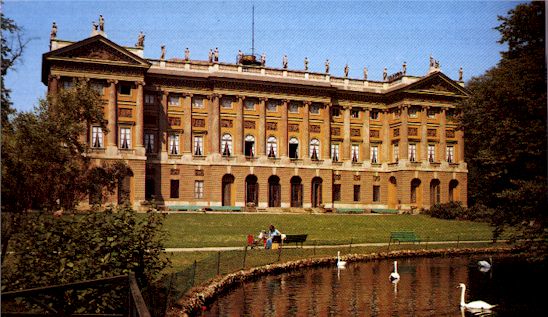 |
Home | Porta Venezia and Neighborhood | Tour's Map | Versione Italiana |
| Milan - Villa Reale (Villa Belgiojoso Bonaparte) - Modern Art Gallery | ||||
 One of the most beautiful neo-classical buildings in Lombardy, built by
Leopoldo Pollack in 1790. The external fašade is rectangular with the
central part faced with rough-hewn blocks on the ground floor, while the two
upper floors conform to the Ionic order. The internal fašade facing the garden
is, however, more beautiful: it's composed of five parts of which three are
protruding and decorated with reliefs of mythological subjects and surrounded
on the top floor by a series of statues of divinities. The bas-reliefs on the
side tympanums represent the chariot of Day and the chariot of Night.
The gardens, a green oasis in downtown Milan, were designed by Piermarini
between 1783 and 1786, and then later enlarged by order of the Austrian emperor
Franz Joseph in 1857. Giuseppe Balzaretto and Alemagna
turned them into English style gardens dotted whit fountais, little lakes and
busts of famous man including a bronze of Giacosa and Confalonieri's
statue of Antonio Richini. The villa was originally the residence of
prince Lodovico Barbiano di Belgioioso. In 1802 the Cisalpine Republic
purchased it to present it to Napoleon when he accepted the presidency
of the Republic and he lived here with his wife Josephine. Eugene
Beauharnais the viceroy of Italy lived here and in 1857, General Radetsky
lived here until his death, on the 5th of January 1858. Finally, in
1859, the Villa passed to the Crown of Italy and then became property of
the City Council. Now owned by the city of Milan, the Villa Reale houses
one of the finest Italian collections of modern art, with a special emphasis on
19th century Lombard painting.
One of the most beautiful neo-classical buildings in Lombardy, built by
Leopoldo Pollack in 1790. The external fašade is rectangular with the
central part faced with rough-hewn blocks on the ground floor, while the two
upper floors conform to the Ionic order. The internal fašade facing the garden
is, however, more beautiful: it's composed of five parts of which three are
protruding and decorated with reliefs of mythological subjects and surrounded
on the top floor by a series of statues of divinities. The bas-reliefs on the
side tympanums represent the chariot of Day and the chariot of Night.
The gardens, a green oasis in downtown Milan, were designed by Piermarini
between 1783 and 1786, and then later enlarged by order of the Austrian emperor
Franz Joseph in 1857. Giuseppe Balzaretto and Alemagna
turned them into English style gardens dotted whit fountais, little lakes and
busts of famous man including a bronze of Giacosa and Confalonieri's
statue of Antonio Richini. The villa was originally the residence of
prince Lodovico Barbiano di Belgioioso. In 1802 the Cisalpine Republic
purchased it to present it to Napoleon when he accepted the presidency
of the Republic and he lived here with his wife Josephine. Eugene
Beauharnais the viceroy of Italy lived here and in 1857, General Radetsky
lived here until his death, on the 5th of January 1858. Finally, in
1859, the Villa passed to the Crown of Italy and then became property of
the City Council. Now owned by the city of Milan, the Villa Reale houses
one of the finest Italian collections of modern art, with a special emphasis on
19th century Lombard painting.The Modern Art Gallery
The museum came into being in 1868 with the Marchesi Fogliani bequest which
was soon broadened by other works either willed or donated to the museum. Both
paintings and sculpture cover a wide range of periods from divisionismo to
futurism. Antonio Canova, Domenico Induno, Giovanni Fattori,
Silvestro Lega are some of the Italian masters displayed, while the French
are represented by Sisley, Gauguin, Manet, Van Gogh,
Renoir and Cézanne. Lesser known to the non-Italian public,
but worthy of a good luck, are the painting by Giovanni Segantini, whose
memorable renderings of simple scenes of everyday life emanate a feeling of great
calm as can be seen in the Two Mothers. Other noteworthy 19th
century Italian artists are Vincenzo Gemito (see his beautiful statue of a
Fisherboy) who treats his figures in the manner of the finest Renaissance
masters, and Mosè Bianchi whose The Washerwomen
confirms the master as one of the foremost of the literary-artistic movement called
Scapigliatura. Medardo Rosso, the great Impressionist sculptor,
has two rooms to himself. Maternity is one of his best pieces, an intensely
emotional and poetic treatment of the theme of motherhood. The Venetian painter
Giacomo Favretto is represented by several works. The Anatomy
Lesson, is a typical example of the painter's oeuvre which reveals the
influence of his Venetian heritage in the use of delicate colour and narrative
themes. Umberto Boccioni, the great early 20th century
Futurist, is well-represented. His Dynamism of a Human Body perfectly
illustrates the artist's theory of universal dynamism. Boccioni paints a synthesis of
what he sees and feels, the objects blending into one other by the play of light,
colour, and line. One step beyond Cubism, the object is no longer static and
immutable, but dynamic and alive. |
| Villa Reale - Modern Art Gallery | Castiglioni Palace | Serbelloni Palace | Casa Fontana-Silvestri | Archbishop's Palace | Clerici Palace | Shopping |